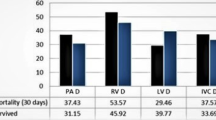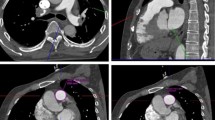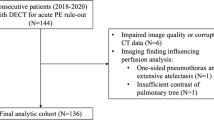Abstract
To compare the ability of CT angiography (CTA) obstruction score and perfusion defect score on dual energy CT perfusion imaging (DEPI) for clinical risk stratification of patients with acute pulmonary embolism (PE). 55 patients diagnosed as acute PE either by CTA or DEPI were retrospectively enrolled. Patients were grouped into high-, intermediate-, and low-risk groups in accordance to the renewed guidelines of 2014. Consistency between DEPI and CTA in diagnosis of PE were assessed. Correlations between CT parameters and right-to-left ventricular (RV/LV) diameter ratio were evaluated. Difference of CTA obstruction score and perfusion defect score across three groups with different risks were analyzed. The consistent rate of DEPI with CTA was 75.4%, and the Kappa value was 0.412 (p = 0.000). 44.3% of partially obstructive PE showed on CTA did not lead to perfusion defect on DEPI. Perfusion defect score was significantly correlated with CTA obstruction score and with RV/LV (r = 0.622 and 0.599, respectively, p < 0.001), and CTA obstruction score had lower correlation with RV/LV (r = 0.403, p = 0.003). Perfusion defect score could distinguish low- from intermediate-risk groups (p = 0.011). However, CTA obstruction score could not distinguish the two groups (p = 0.149). DEPI had fine consistency with CTA to diagnose acute PE and offered additional information of physiologic changes. Comparing with CTA obstruction score, perfusion defect score could better correlate with right ventricular dysfunction, and could be a more promising biomarker for clinical risk stratification.





Similar content being viewed by others
References
Piazza G, Goldhaber SZ (2006) Acute pulmonary embolism: part I: epidemiology and diagnosis. Circulation 114:e28–e32
Konstantinides SV, Torbicki A, Agnelli G, Danchin N, Fitzmaurice D, Galiè N, Gibbs JS, Huisman MV, Humbert M, Kucher N, Lang I, Lankeit M, Lekakis J, Maack C, Mayer E, Meneveau N, Perrier A, Pruszczyk P, Rasmussen LH, Schindler TH, Svitil P, Vonk Noordegraaf A, Zamorano JL, Zompatori M; Task Force for the Diagnosis and Management of Acute Pulmonary Embolism of the European Society of Cardiology (2014) ESC guidelines on the diagnosis and management of acute pulmonary embolism, Eur Heart J, 35 (2014) 3033–3069
van der Meer RW, Pattynama PM, van Strijen MJ, van den Berg-Huijsmans AA, Hartmann IJ, Putter H, de Roos A, Huisman MV (2005) Right ventricular dysfunction and pulmonary obstruction index at helical CT: prediction of clinical outcome during 3-month follow-up in patients with acute pulmonary embolism. Radiology 235:798–803
Becattini C, Agnelli G, Germini F, Vedovati MC (2014) Computed tomography to assess risk of death in acute pulmonary embolism: a meta-analysis. Eur Respir J 43:1678–1690
Meyer M, Haubenreisser H, Sudarski S, Doesch C, Ong MM, Borggrefe M, Schoenberg SO, Henzler T (2015) Where do we stand? Functional imaging in acute and chronic pulmonary embolism with state-of-the-art CT. Eur J Radiol 84:2432–2437
Stein PD, Fowler SE, Goodman LR, Gottschalk A, Hales CA, Hull RD, Leeper KV Jr, Popovich J Jr, Quinn DA, Sos TA, Sostman HD, Tapson VF, Wakefield TW, Weg JG, Woodard PK, Investigators PI (2006) Multidetector computed tomography for acute pulmonary embolism. N Engl J Med 354:2317–2327
Remy-Jardin M, Pistolesi M, Goodman LR, Gefter WB, Gottschalk A, Mayo JR, Sostman HD (2007) Management of suspected acute pulmonary embolism in the era of CT angiography: a statement from the Fleischner Society. Radiology 245:315–329
Chae EJ, Seo JB, Jang YM, Krauss B, Lee CW, Lee HJ (2010) K.S. Song, Dual-energy CT for assessment of the severity of acute pulmonary embolism: pulmonary perfusion defect score compared with CT angiographic obstruction score and right ventricular/left ventricular diameter ratio. AJR Am J Roentgenol 194:604–610
Lee CW, Seo JB, Song JW, Kim MY, Lee HY, Park YS, Chae EJ, Jang YM, Kim N, Krauss B (2011) Evaluation of computer-aided detection and dual energy software in detection of peripheral pulmonary embolism on dual-energy pulmonary CT angiography. Eur Radiol 21:54–62
Kang MJ, Park CM, Lee CH, Goo JM, Lee HJ (2010) Dual-energy CT: clinical applications in various pulmonary diseases. Radiographics 30:685–698
Thieme SF, Johnson TR, Lee C, McWilliams J, Becker CR, Reiser MF, Nikolaou K (2009) Dual-energy CT for the assessment of contrast material distribution in the pulmonary parenchyma. AJR Am J Roentgenol 193:144–149
Sakamoto A, Sakamoto I, Nagayama H, Koike H, Sueyoshi E, Uetani M (2014) Quantification of lung perfusion blood volume with dual-energy CT: assessment of the severity of acute pulmonary thromboembolism. AJR Am J Roentgenol 203:287–291
Meinel FG, Graef A, Bamberg F, Thieme SF, Schwarz F, Sommer WH, Neurohr C, Kupatt C, Reiser MF, Johnson TR (2013) Effectiveness of automated quantification of pulmonary perfused blood volume using dual-energy CTPA for the severity assessment of acute pulmonary embolism. Invest Radiol 48:563–569
Pontana F, Faivre JB, Remy-Jardin M, Flohr T, Schmidt B, Tacelli N, Pansini V, Remy J (2008) Lung perfusion with dual-energy multidetector-row CT (MDCT): feasibility for the evaluation of acute pulmonary embolism in 117 consecutive patients. Acad Radiol 15:1494–1504
Hoey ET, Gopalan D, Ganesh V, Agrawal SK, Qureshi N, Tasker AD, Clements L, Screaton NJ (2009) Dual-energy CT pulmonary angiography: a novel technique for assessing acute and chronic pulmonary thromboembolism. Clin Radiol 64:414–419
Kim BH, Seo JB, Chae EJ, Lee HJ, Hwang HJ, Lim C (2012) Analysis of perfusion defects by causes other than acute pulmonary thromboembolism on contrast-enhanced dual-energy CT in consecutive 537 patients. Eur J Radiol 81:e647–e652
Zhang LJ, Yang GF, Zhao YE, Zhou CS, Lu GM (2009) Detection of pulmonary embolism using dual-energy computed tomography and correlation with cardiovascular measurements: a preliminary study. Acta Radiol 50:892–901
Qanadli SD, El Hajjam M, Vieillard-Baron A, Joseph T, Mesurolle B, Oliva VL, Barre O, Bruckert F, Dubourg O, Lacombe P (2001) New CT index to quantify arterial obstruction in pulmonary embolism: comparison with angiographic index and echocardiography. AJR Am J Roentgenol 176:1415–1420
Henzler T, Krissak R, Reichert M, Sueselbeck T, Schoenberg SO, Fink C (2010) Volumetric analysis of pulmonary CTA for the assessment of right ventricular dysfunction in patients with acute pulmonary embolism. Acad Radiol 17:309–315
Kamel EM, Schmidt S, Doenz F, Adler-Etechami G, Schnyder P, Qanadli SD (2008) Computed tomographic angiography in acute pulmonary embolism: do we need multiplanar reconstructions to evaluate the right ventricular dysfunction? J Comput Assist Tomogr 32:438–443
Nikolaou K, Thieme S, Sommer W, Johnson T, Reiser MF (2010) Diagnosing pulmonary embolism: new computed tomography applications. J Thorac Imaging 25:151–160
Thieme SF, Ashoori N, Bamberg F, Sommer WH, Johnson TR, Leuchte H, Becker A, Maxien D, Helck AD, Behr J, Reiser MF, Nikolaou K (2012) Severity assessment of pulmonary embolism using dual energy CT—correlation of a pulmonary perfusion defect score with clinical and morphological parameters of blood oxygenation and right ventricular failure. Eur Radiol 22:269–278
Bauer RW, Frellesen C, Renker M, Schell B, Lehnert T, Ackermann H, Schoepf UJ, Jacobi V, Vogl TJ, Kerl JM (2011) Dual energy CT pulmonary blood volume assessment in acute pulmonary embolism—correlation with D-dimer level, right heart strain and clinical outcome. Eur Radiol 21:1914–1921
Apfaltrer P, Bachmann V, Meyer M, Henzler T, Barraza JM, Gruettner J, Walter T, Schoepf UJ, Schoenberg SO, Fink C (2012) Prognostic value of perfusion defect volume at dual energy CTA in patients with pulmonary embolism: correlation with CTA obstruction scores, CT parameters of right ventricular dysfunction and adverse clinical outcome. Eur J Radiol 81:3592–3597
Funding
This work was supported by the Miaopu Project, Sichuan Provincial People’s Hospital, China, No. 2015MP29. The authors thanks Jinliang Hu, a statistician from Sichuan Provincial People’s hospital, for the consultation about statistic methodology.
Author information
Authors and Affiliations
Corresponding author
Ethics declarations
Conflict of interest
The authors declare that they have no conflict of interest.
Rights and permissions
About this article
Cite this article
Kong, WF., Wang, YT., Yin, LL. et al. Clinical risk stratification of acute pulmonary embolism: comparing the usefulness of CTA obstruction score and pulmonary perfusion defect score with dual-energy CT. Int J Cardiovasc Imaging 33, 2039–2047 (2017). https://doi.org/10.1007/s10554-017-1188-x
Received:
Accepted:
Published:
Issue Date:
DOI: https://doi.org/10.1007/s10554-017-1188-x




